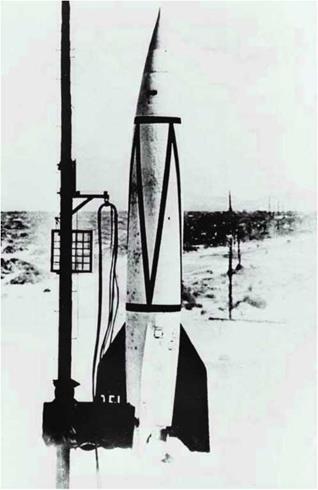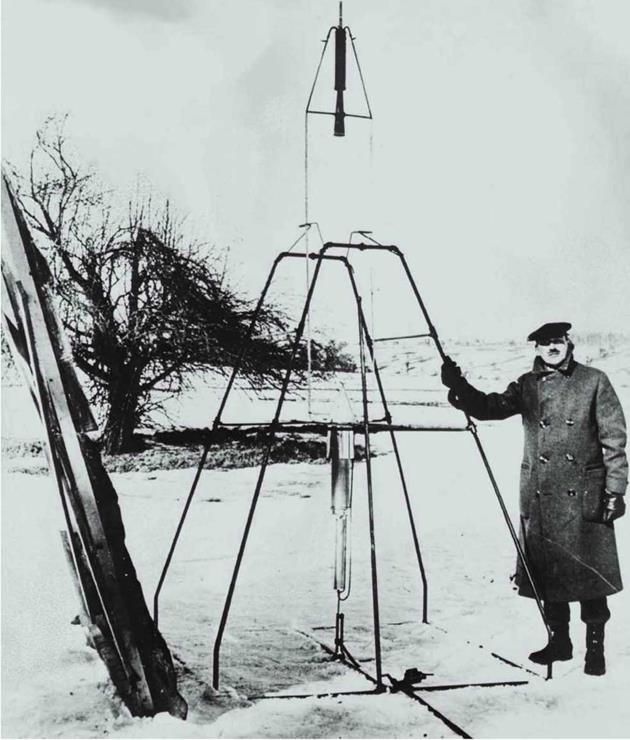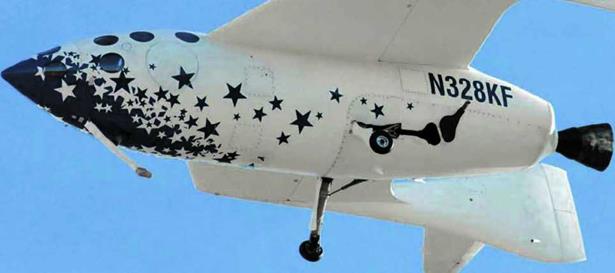Threads of Rocketry
Robert Goddard built and launched the very first liquid-fuel rocket in 1926, shown in figure 2.17, and is now considered the father of American rocketry. Yet when he first published theories about reaching the Moon using a rocket, he drew ridicule, so much so that he fled to the remoteness of Roswell, New Mexico, to continue his pioneering research. Ironically, it was prewar Germany that seemed to take his work more seriously than did his own country.
But Goddard still had a few pretty important believers in his work. Charles Lindbergh had recognized that wings and propellers could
|
|
ґ
Fig. 2.17. Robert Goddard was a pioneer in rocketry. In this photo from 1926, he stands next to his invention, the very first liquid-fueled rocket. His breakthroughs were, unfortunately, not enough to shield him from relentless ridicule when he asserted that a large enough rocket could reach the Moon. NASA-Marshall Space Flight Center
 |
 |
(
Fig. 2.18. Charles Lindbergh (right) understood early on that airplanes had limitations. He was fascinated by rocketry because he knew this would be the next step. A kindred spirit, Lindbergh helped Robert Goddard (center) to get funding from the Guggenheim family. This photograph from 1935 shows Harry F. Guggenheim (left) visiting for a rocket launch. NASA-Headquarters
V___________________ J
Ґ Л
Fig. 2.19. The first man-made object to reach the edge of space, the V-2, was designed and built by Germany during World War II. Thousands and thousands of these ballistic missiles rained down on cities, with Antwerp and London being the targets of the vast majority. After the war, this vengeance or terror weapon became the foundation of the intercontinental ballistic missile (ICBM) and space programs of the United States and Soviet Union. NASA-Marshall Space Flight Center
V_____________________________________ J
carry an aircraft only so high. Because of this, Lindbergh was very interested in rocketry and in Goddard’s work. Lindbergh was able to help secure funding for Goddard from the wealthy Guggenheim family. Figure 2.18 shows Lindbergh together with Goddard and his benefactor for the launch of one of Goddard’s more advanced rockets.
Right after World War II, when the German rocket scientists who worked on the V-2 rockets left for the United States or Russia, the United States asked Lindbergh to go to Germany and assess what was
left of the V-2 program. Figure 2.19 shows a V-2. It was not only a weapon of war, but it also was the foundation upon which the U. S. space program was built. Even an Ansari X Prize team, Canada’s Red Arrow, used it as the basis for their spacecraft.
So, early on, Charles Lindbergh was exposed to the work of Wernher von Braun. And it was von Braun who helped the United States to reach the surface of the Moon. It is hard not to see all the connections and parallels between this and the present.
|
|
SpaceShipOne may look like an airplane, but it is actually a combination of a missile launching from an aircraft, a spaceship maneuvering above the atmosphere, and a glider drifting down to Earth. Mojave Aerospace Ventures LLC, photograph by David M. Moore












